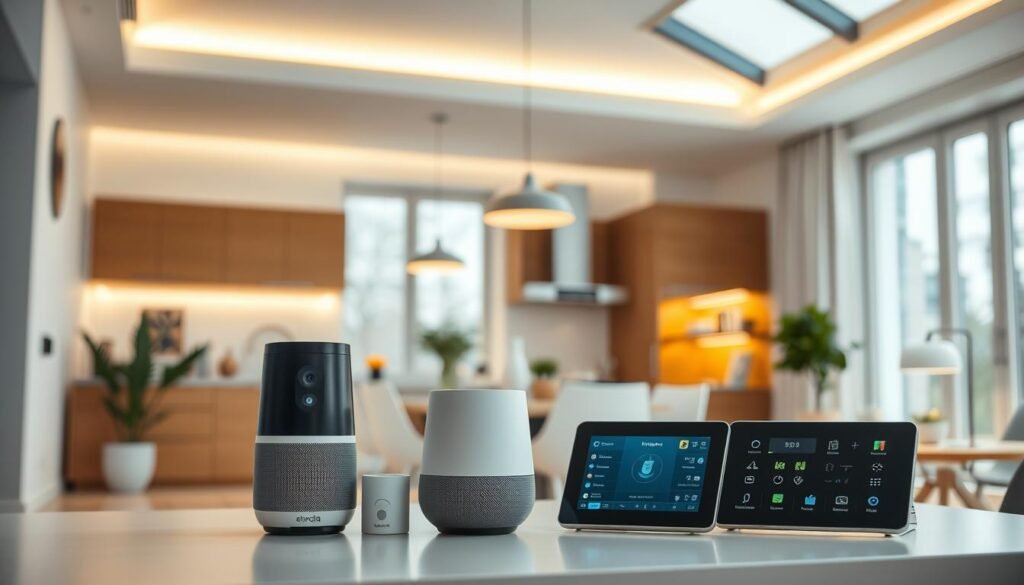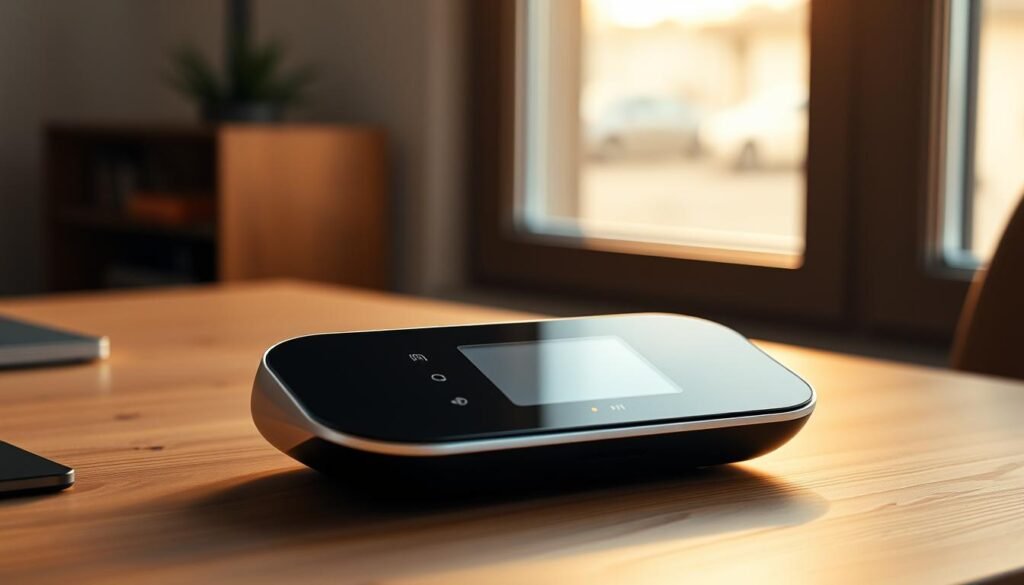Table of Contents
Have you ever wondered how your home could become more intuitive and responsive to your needs? The answer lies in the seamless integration of advanced technology into our daily lives. From voice-activated assistants to automated security systems, these innovations are reshaping the way we interact with our living spaces.
At the heart of this transformation is the fusion of machine learning and natural language processing. These technologies enable devices to learn from our habits, anticipate our needs, and provide personalized experiences. Whether it’s optimizing energy usage or enhancing security, the benefits are undeniable.
Looking ahead, the future promises even greater connectivity and efficiency. As we continue to embrace these advancements, our world will become more interconnected, making everyday tasks simpler and more enjoyable. This article explores how these innovations are revolutionizing our lives and what lies ahead.
Key Takeaways
- AI-driven devices are making homes more intuitive and efficient.
- Machine learning and natural language processing are key drivers of innovation.
- Smart home technology enhances energy efficiency and security.
- Future advancements will focus on greater connectivity and personalization.
- Real-world applications are already improving daily life.
The Evolution of AI in Everyday Technology
Over the years, the way we interact with our living spaces has evolved dramatically. What began as simple programmable routines has transformed into sophisticated systems that enhance our daily lives. This journey from concept to reality has been driven by groundbreaking advancements in technology.
From Concept to Reality in Home Automation
Early home automation relied on basic programmable logic. These systems could perform tasks like turning lights on and off at set times. However, they lacked the ability to adapt to user preferences or learn from behavior.
Today, advanced software and machine learning models have revolutionized these capabilities. Modern devices can now analyze data, predict needs, and offer personalized experiences. This shift has made our homes more intuitive and efficient.
Key Technological Breakthroughs Boosting Innovation
Several innovations have played a crucial role in this transformation. Advances in machine learning have enabled devices to process vast amounts of data and improve over time. Similarly, natural language processing has enhanced human-machine interactions, making communication seamless.
Robust hardware and improved software have also been game-changers. These advancements have allowed for the development of robots that assist with domestic tasks, from cleaning to organizing. Together, these breakthroughs have laid the foundation for the modern smart home ecosystem.
As we continue to innovate, the future promises even greater connectivity and efficiency. These advancements will further integrate technology into our lives, making everyday tasks simpler and more enjoyable.
Exploring artificial intelligence in smart devices
Modern homes are becoming more intuitive thanks to cutting-edge innovations. At the core of this transformation is the seamless integration of machine learning and natural language processing. These technologies enable devices to adapt to our needs, making everyday tasks simpler and more efficient.

Integrating Machine Learning and Natural Language Processing
Machine learning allows devices to analyze data and improve over time. This means your home can learn your preferences and adjust settings automatically. For example, thermostats can optimize energy usage based on your daily routine.
Natural language processing enhances communication between users and their devices. Voice-activated assistants can understand commands and respond in a way that feels natural. This makes interactions smoother and more intuitive.
Real-World Examples Transforming User Experiences
AI-powered devices are already making a significant impact. Smart speakers can play your favorite music or control other connected devices with a simple voice command. Security systems can detect unusual activity and alert you in real-time.
These innovations are not just about convenience. They also enhance safety and efficiency in our homes. By automating routine tasks, they free up time for more important activities.
As these technologies continue to evolve, we can expect even greater advancements. The future of smart homes lies in creating systems that are more adaptive, efficient, and user-friendly.
Smart Home: Energy Management and Security Innovations
The way we manage energy and security in our home is undergoing a significant transformation. With the help of advanced technologies, we can now optimize energy usage and enhance safety like never before. These innovations are not just about convenience; they also contribute to a more sustainable and secure living environment.
AI-Powered Energy Monitoring and Optimization
One of the most impactful advancements is the ability to monitor and optimize energy consumption. Smart systems analyze usage patterns and adjust settings to reduce waste. For example, thermostats can learn your schedule and adjust temperatures accordingly, saving up to 30% on energy bills.
These systems also integrate with renewable energy sources, like solar panels, to maximize efficiency. By continuously monitoring and adapting, they ensure that your home operates at peak performance while minimizing environmental impact.
Advanced Security Systems and Anomaly Detection
Security has also seen remarkable improvements. Modern systems use advanced algorithms to detect unusual activity and alert homeowners in real-time. This reduces false alarms by up to 50%, ensuring that you only receive alerts when there’s a genuine threat.
These systems can even integrate with robots for surveillance, providing an extra layer of protection. Whether it’s detecting intruders or monitoring for hazards, these innovations make your home safer and more secure.
Seamless Integration with Smart Grid Technologies
Another key development is the integration with smart grid technologies. This allows your home to communicate with the broader energy network, optimizing power distribution and reducing costs. During peak demand, your system can adjust usage to avoid overloading the grid.
This seamless integration ensures that your home is not only efficient but also contributes to a more stable energy infrastructure. Together, these advancements are transforming how we manage energy and security, making our lives easier and more sustainable.
Voice-Controlled Assistants and Personalized Automation
Voice-controlled assistants are reshaping how we interact with technology in our daily lives. These tools, like Alexa and Google Assistant, have become essential for managing tasks and routines. By understanding natural language, they create a seamless and intuitive experience for users.

One of the key advancements is their ability to engage in multi-turn conversations. This means they can handle complex requests without needing repeated commands. For example, you can ask your assistant to play music, adjust the lights, and set a reminder—all in one interaction.
These systems also adapt to individual preferences through continuous learning. Over time, they analyze your habits and tailor their responses to suit your needs. This personalization makes everyday tasks more efficient and enjoyable.
With the integration of smartphone apps, controlling your home has never been easier. Whether you’re at home or on the go, these assistants provide unparalleled convenience. They are transforming how we live, making technology more accessible and user-friendly.
Advancing Health and Predictive Remote Monitoring
The integration of advanced technology into health monitoring is revolutionizing how we care for ourselves and our loved ones. By leveraging data from wearables, sensors, and other devices, we can now track vital signs and detect potential issues before they escalate. This proactive approach is transforming the way we manage our well-being.
Continuous Health Data Collection Through Smart Devices
Modern devices like wearables and smartphone apps are designed to collect data around the clock. They monitor heart rate, blood pressure, and even sleep patterns. This continuous monitoring provides a comprehensive view of an individual’s health, enabling early detection of irregularities.
For example, a camera-based system can track movement and detect falls in real-time. This is especially useful for elderly individuals living alone. By combining data from multiple sources, these systems create a robust network for health management.
Predictive Analytics for Improved Emergency Response
Predictive analytics play a crucial role in enhancing emergency response. By analyzing data from devices, these systems can identify patterns that indicate potential health risks. For instance, a sudden drop in oxygen levels could trigger an alert for immediate medical attention.
These systems also integrate with home security networks, ensuring that help is dispatched quickly in case of an emergency. This seamless coordination between monitoring tools and emergency services can save lives and improve outcomes.
As technology continues to evolve, the future of health monitoring looks promising. With advancements in data analysis and device integration, we can expect even greater accuracy and efficiency in managing our well-being.
Conclusion
The journey of integrating advanced technologies into our daily lives has reached a pivotal moment. From automating routine tasks to enhancing health monitoring, these innovations are reshaping how we interact with our home environments. The seamless blend of machine learning and natural language processing has made devices more intuitive, offering personalized experiences tailored to individual user needs.
Voice-controlled assistants and robots have simplified daily routines, while energy management systems optimize efficiency. These advancements not only improve convenience but also contribute to sustainability and security. As we embrace these solutions, it’s essential to balance innovation with ethical considerations, ensuring privacy and trust remain priorities.
Looking ahead, the potential for further growth is immense. By staying engaged with ongoing developments, we can unlock even greater benefits. Let’s continue exploring how these technologies can enhance our lives, making our smart home ecosystems more connected, efficient, and user-friendly.
FAQ
How is machine learning integrated into home automation systems?
Machine learning enhances home automation by analyzing user behavior and preferences. This allows devices to adapt routines, optimize energy usage, and improve security based on real-time data.
What role does natural language processing play in voice-controlled assistants?
Natural language processing enables voice assistants to understand and respond to user commands more accurately. It improves interactions by recognizing context, accents, and conversational nuances.
How do AI-powered security systems detect anomalies?
These systems use advanced algorithms to monitor activity patterns. When unusual behavior is detected, such as unexpected motion or access attempts, they alert homeowners and take preventive actions.
Can smart devices help manage household energy consumption?
Yes, AI-driven energy monitoring systems analyze usage patterns and suggest optimizations. They can adjust lighting, heating, and cooling to reduce costs while maintaining comfort.
What are the benefits of predictive health monitoring through smart devices?
Predictive health monitoring collects continuous data, such as heart rate and activity levels. It uses this information to identify potential health issues early, enabling timely interventions.
How do smart home devices adapt to user preferences?
These devices learn from daily routines and user interactions. Over time, they personalize settings like lighting, temperature, and entertainment to match individual preferences.
What advancements have made smart grids more efficient?
Smart grids use AI to balance energy supply and demand in real time. They integrate renewable energy sources and optimize distribution, reducing waste and improving reliability.
How does AI improve emergency response in smart homes?
AI systems can detect emergencies like fires or medical incidents. They automatically alert authorities, provide location details, and guide family members to safety.


